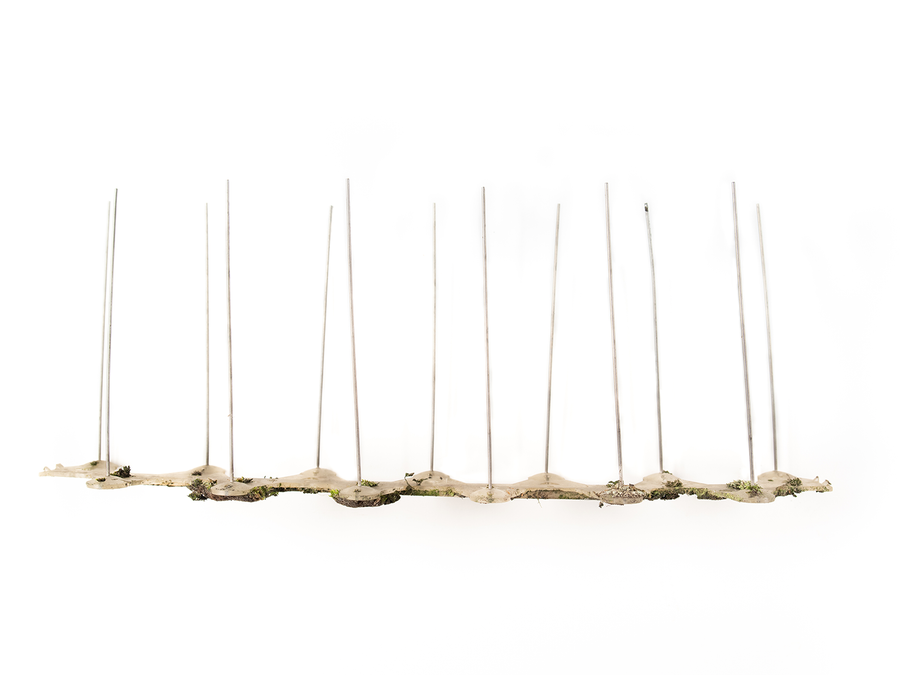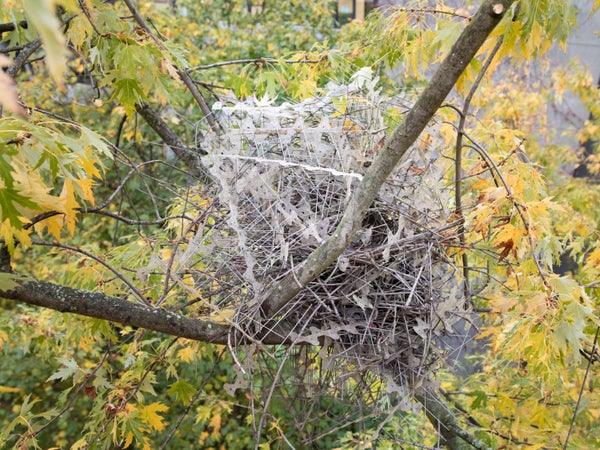Naturalist Auke-Florian Hiemstra has seen a lot of bird nests, but none were quite like the one he spotted in a photograph from a patient in a Belgian hospital. This nest, high in a sugar maple in the hospital’s courtyard, was massive—and looked like metal.
“It just was this very big ball of metallic, nasty bird spikes,” Hiemstra says. On closer inspection, he realized a Eurasian Magpie (Pica pica) had built the two-foot-wide nest with materials that included some 1,500 spikes of the type cities often use to fend off feathered loiterers. Hiemstra ventured out onto the hospital’s roof only to find that the roof’s edge facing the courtyard was lined by a bare strip of glue, just like the kind often used to attach these spikes. And, perhaps strangest of all, the bird seemed to have arranged the spikes to form a defensive roof over the nest, much like the kind magpies often build out of thorny branches that they travel long distances to collect.
“It sounds like a joke,” says Hiemstra, a Ph.D. candidate in evolutionary ecology at Naturalis Biodiversity Center in the Netherlands. “I think it’s so funny that now they’ve started to use these anti-bird spikes in the same way that we intended them to be used.”
On supporting science journalism
If you're enjoying this article, consider supporting our award-winning journalism by subscribing. By purchasing a subscription you are helping to ensure the future of impactful stories about the discoveries and ideas shaping our world today.
Hiemstra is a co-author of a new study published online July 11 in Deinsea, in which the researchers describe the Belgian nest and several similar spiky structures found across Europe: two magpie nests from Scotland and the Netherlands, and one Carrion Crow (Corvus corone) nest, also from the Netherlands. The scientists also mention a spike-embellished Carrion Crow nest reported in a 2009 paper and several reports from social media of birds interacting with rooftop anti-bird spikes—and even building nests directly over them.

Anti-bird spikes used in bird nests. Credit: Auke-Florian Hiemstra/Naturalis
Interestingly, the crows whose nests the researchers studied seemed to use the spikes not as defenses but as structural support, with the sharp ends pointed harmlessly inward. Crows and most magpies belong to a group scientists call corvids, which are known for being particularly clever.
“Corvids, as a family, are among the most intelligent of all animals—certainly of birds, but really across all organisms as we understand them,” says Kaeli Swift, an avian ecologist at the University of Washington who specializes in corvids. Swift wasn’t involved in the new research, but she says she isn’t surprised to see crows and magpies experimenting with unconventional nesting techniques.
Birds around the world use human materials in their nests in various ways, says Juan Diego Ibáñez Álamo, an urban ecologist at the University of Granada in Spain, who wasn’t involved in the new research. The use of anti-bird spikes is just an unusually ironic example of the behavior, Hiemstra says.
In a review published earlier this month, Ibáñez Álamo and his colleagues found that while the most common human material found in birds’ nests is plastic, these structures also incorporate things such as glass, cloth and even cigarette butts. And anthropogenic materials are found even in nests in areas people might consider pristine. “It’s not really related to more polluted areas,” Ibáñez Álamo says. “It’s not something that is restricted to cities. It’s everywhere.”
Because the nests featured in the paper are scattered across Europe, Hiemstra thinks many birds are independently exploring the reuse of anti-bird spikes—and he says he hopes that with the phenomenon now documented, curious observers will report other examples of nests that incorporate these spikes to help scientists better understand the behavior.
Hiemstra would also like to determine whether the unconventional nest material is helping or hurting these birds. Swift imagines experiments testing whether magpie predators are able to evade the seemingly defensive spikes, as well as observational studies comparing the nesting success rates of spike users with more traditional builders of the same species, that could be done to find out.
“We don’t know what happened in the nests—if there was successful breeding, if there was breeding at all,” says Zuzanna Jagiełło, a biologist at the University of Warsaw in Poland who worked with Ibáñez Álamo on the review of birds’ use of anthropogenic materials but wasn’t involved in the recent spike research.
For now Hiemstra says he’s taking hope from what he sees as an example of nature fighting back. “Using the material meant to scare birds off, using that to actually make more birds—I think it’s the perfect revenge,” he says.
